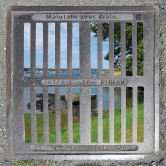 Catch basins are chambers, usually with a grate, which collect stormwater. They are very common in parking lots and on streets. In addition to rainwater, catch basins can collect litter, car fluids (oils, gas, antifreeze, etc.), metals, sediments, leaves, sand, grit and/or soil.
Catch basins are chambers, usually with a grate, which collect stormwater. They are very common in parking lots and on streets. In addition to rainwater, catch basins can collect litter, car fluids (oils, gas, antifreeze, etc.), metals, sediments, leaves, sand, grit and/or soil.
The catch basin helps remove pollution by allowing solids to settle and light materials to float. These units discharge to stormwater systems that lead to nearby water bodies, such as streams, wetlands or the ocean. When maintained and serviced properly, catch basins effectively reduce the amount of pollution leading to our waterways, beaches and marine shorelines.
With a changing climate and more intense rainfall in the winter months, it is even more important to clean out catch basins to avoid flooding, damage to your and nearby businesses and to protect the environment.
Catch Basin Best Management Practices